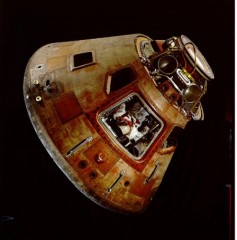
Apollo 11 Command Module "Columbia"; photo courtesy Smithsonian Institution
Forty-two years ago today, Neil Armstrong became the first human to set foot on the Earth’s moon. Today’s Smithsonian Snapshot takes a look at the Columbia, the lunar command module for the first manned lunar landing mission. (The first Space Shuttle was named after this module.)
On July 16, 1969, Neil Armstrong, Edwin “Buzz” Aldrin and Michael Collins were launched from Cape Kennedy atop a Saturn V rocket. The Columbia was the living quarters for the three-person crew during most of the mission in July 1969. This Command Module, no. 107, manufactured by North American Rockwell, was one of three parts of the complete Apollo spacecraft. The other two parts were the Service Module and the Lunar Module, nicknamed “Eagle.” The Service Module contained the main spacecraft propulsion system and consumables while the Lunar Module was the two-person craft used by Armstrong and Aldrin to descend to the Moon’s surface on July 20.
The Columbia is the only portion of the spacecraft to return to Earth. It was transferred to the Smithsonian in 1970 following a NASA-sponsored tour of American cities and can be found as one of the primary exhibits at the Smithsonian’s National Air and Space Museum.